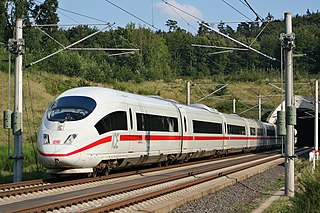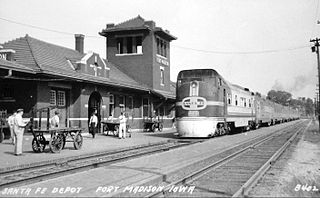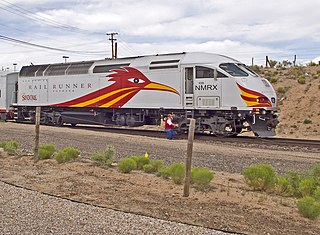
A train is a series of connected vehicles that run along a railway track and transport people or freight. Trains are typically pulled or pushed by locomotives, though some are self-propelled, such as multiple units. Passengers and cargo are carried in railroad cars, also known as wagons. Trains are designed to a certain gauge, or distance between rails. Most trains operate on steel tracks with steel wheels, the low friction of which makes them more efficient than other forms of transport.

A multiple-unit train or simply multiple unit (MU) is a self-propelled train composed of one or more carriages joined, which when coupled to another multiple unit can be controlled by a single driver, with multiple-unit train control.

A railcar is a self-propelled railway vehicle designed to transport passengers. The term "railcar" is usually used in reference to a train consisting of a single coach, with a driver's cab at one or both ends. Some railway companies, such as the Great Western, termed such vehicles "railmotors".

A bilevel car or double-decker coach is a type of rail car that has two levels of passenger accommodation as opposed to one, increasing passenger capacity.

The PATCO Speedline, signed in Philadelphia as the Lindenwold Line and also known colloquially as the PATCO High Speed Line, is a rapid transit route operated by the Port Authority Transit Corporation (PATCO), which runs between Philadelphia, Pennsylvania, and Camden County, New Jersey.

The R46 is a New York City Subway car model that was built by the Pullman Standard Company from 1975 to 1978 for the IND/BMT B Division. They replaced all remaining Arnine cars and General Electric-powered R16s, and some R10s. The R46 order initially consisted of 754 single cars, each 75 feet (23 m) long, and was the largest single order of passenger cars in United States railroad history at the point of the fleet's completion. The R46 was the second order of 75-foot cars to be ordered for the New York City Subway, after the R44s.

Brookville Equipment Corporation, based in Brookville, Pennsylvania, United States, manufactures railroad locomotives for industrial and light capacity switching needs. The company also builds and restores streetcars. The company used to be known as Brookville Locomotive Company.

Electro-Motive Corporation produced five 1800 hp B-B experimental passenger train-hauling diesel locomotives in 1935; two company-owned demonstrators, #511 and #512, the Baltimore and Ohio Railroad's #50, and two units for the Atchison, Topeka and Santa Fe Railway, Diesel Locomotive #1. The twin engine power unit layout and multiple unit control systems developed with the B-B locomotives were soon adopted for other locomotives such as the Burlington Route's Zephyr locomotives built by the Budd Company in 1936 and EMC's own EMD E-units introduced in 1937. The B-B locomotives worked as proof-of-concept demonstrators for diesel power with the service loads of full size trains, breaking out of its niche powering the smaller custom Streamliners.

The Budd Company was a 20th-century metal fabricator, a major supplier of body components to the automobile industry, and a manufacturer of stainless steel passenger rail cars, airframes, missile and space vehicles, and various defense products.

The Budd Rail Diesel Car (RDC), also known as the Budd car or Buddliner, is a self-propelled diesel multiple unit (DMU) railcar. Between 1949 and 1962, 398 RDCs were built by the Budd Company of Philadelphia, Pennsylvania, United States. The cars were primarily adopted for passenger service in rural areas with low traffic density or in short-haul commuter service, and were less expensive to operate in this context than a traditional diesel locomotive-drawn train with coaches. The cars could be used singly or coupled together in train sets and controlled from the cab of the front unit. The RDC was one of the few DMU trains to achieve commercial success in North America. RDC trains were an early example of self-contained diesel multiple unit trains, an arrangement now in common use by railways all over the world.

The Coast Daylight, originally known as the Daylight Limited, was a passenger train on the Southern Pacific Railroad (SP) between Los Angeles and San Francisco, California, via SP's Coast Line. It was advertised as the "most beautiful passenger train in the world," carrying a particular red, orange, and black color scheme. The train operated from 1937 until 1974, being retained by Amtrak in 1971. Amtrak merged it with the Coast Starlight in 1974.

The Siemens S70; its successor, the S700; and European variant, the Avanto; are a series of low-floor light-rail vehicles (LRV) and streetcars manufactured by Siemens Mobility, a division of German conglomerate Siemens AG.

The MPI MPXpress is a line of diesel-electric locomotives built by MotivePower for commuter rail service. There are five MPXpress models: MP36PH-3S, MP36PH-3C, MP40PH-3C, MP32PH-Q, and MP54AC.

A passenger train is a train used to transport people along a railroad line. These trains may consist of unpowered passenger railroad cars hauled by one or more locomotives, or may be self-propelled; self propelled passenger trains are known as multiple units or railcars. Passenger trains stop at stations or depots, where passengers may board and disembark. In most cases, passenger trains operate on a fixed schedule and have priority over freight trains.

The Twin Cities Hiawatha, often just Hiawatha, was a named passenger train operated by the Chicago, Milwaukee, St. Paul and Pacific Railroad, and traveled from Chicago to the Twin Cities. The original train takes its name from the epic poem The Song of Hiawatha by Henry Wadsworth Longfellow. There are a number of Hiawatha-themed names within the city of Minneapolis, the terminus of the original train. The first Hiawatha ran in 1935; in 1939 the Milwaukee Road introduced a second daily trip between Chicago and Minneapolis. The two trains were known as the Morning Hiawatha and Afternoon Hiawatha, or sometimes the AM Twin Cities Hiawatha and PM Twin Cities Hiawatha. The Milwaukee Road discontinued the Afternoon Hiawatha in 1970 while the Morning Hiawatha continued running until the formation of Amtrak in 1971.

The Jersey Arrow is a type of electric multiple unit (EMU) railcar developed for the Pennsylvania Railroad, and used through successive commuter operators in New Jersey, through to NJ Transit. Three models were built, but only the third model is in use today. The series is similar to SEPTA's Silverliner series, but include center doors among other differences in details.
The Los Angeles County Metropolitan Transportation Authority (Metro) operates six rail lines as part of its Metro Rail system. This system includes four light rail lines and two rapid transit lines. The agency owns, operates, and maintains a fleet of 439 rail vehicles.

Silverliner is the name given to a series of electric multiple unit (EMU) railcars in commuter rail service in the Philadelphia area since 1958. As of the introduction of the Silverliner V in 2009–2010, there have been 5 generations of Silverliner cars, identified by the Roman numerals I through V placed after the name Silverliner. The Silverliner name came from the classes' shiny stainless steel body shell, which contrasted with the painted and frequently rusting carbon steel railcars used by the Pennsylvania and Reading Railroads between 1915 and 1936. Applied to the first large production order in 1963, the cars made such an impression that the name has since been applied to all subsequent MU classes purchased by SEPTA for the Regional Rail services.

The Silverliner IV is the fourth-generation electric multiple unit railcar in the Silverliner family. It was designed and built by General Electric and was delivered between 1973 and 1976. It operates on the SEPTA Regional Rail network throughout Greater Philadelphia.



















